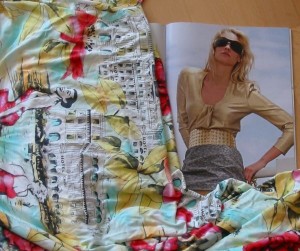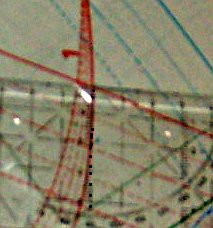Jeder der Schnitt verändert oder an Schnitten herumbastelt kommt irgendwann zu dieser Frage: Wie viel mehr an Stoff brauche ich im Vergleich zu meinen Körpermaßen?
Gut, bei Jersey und anderen elastischen Stoffen dehnt sich das eine oder andere hin (auch wenn es nicht immer gut aussieht…) aber bei festen Stoffen führt zu wenig Stoff schnell zu einer „Bewegungskatastrophe“.
Ein Artikel in der Sew News April/Mai erinnerte mich wieder an die unzähligen Diskussionen die ich mit anderen Hobbyschneiderinnnen dazu schon geführt habe, sowie die vielen Fragen, die immer offen blieben. Deswegen gibt es hier mal Zahlen, Zahlen, Zahlen… 😉 (Neben dem bereits genannten Artikel habe ich auch noch in den Konstruktionsbüchern von Rene Bergh und Pamela Stringer nachgesehen.)
Everyone who is transforming patterns arrives at this question sooner or later: What difference do I need between the body measurements and pattern measurements?
If you are using knits the stretch can help (even if it does not always look perfekt…), but with a firm fabric you easily arrive at a situation where you can put on your skirt, but not sit in it… 😮
The article in a Sew News this spring reminded me of countless discussions among co-sewers and all the questions we could only guess, but not really answer. So here are some numbers… (This entry does not only include the Sew News article, I also checked my books about pattern construction by Rene Bergh and Pamela Stringer.)
Zuerst einmal muß man unterscheiden zwischen der Bewegungszugabe und der Designzugabe.
Die Bewegungszugabe ist das nötige Minimum, damit ein Kleidungsstück gut fällt und man sich auch noch darin bewegen kann. Der Schnitt muß also immer etwas größer sein, als der Körperumfang. (Die wenigen Ausnahmen mit „negativer Zugabe“ mal außer acht gelassen, das betrifft vor allem elastische Stoffe bei Unterwäsche und Sportkleidung.)
Ich weiß, daß es einige Leute gibt, die der Meinung sind, sie hätten das nicht nötig, weil sie so schlank sind. Hier ein kleiner Tip: Bittet einmal einen Tag lang einen Freund Photos von euerer Rückansicht zu machen. Bei ganz normalen Bewegungen wie laufen, sitzen, essen, am Computer sitzen,… Was ich sehe, wenn ich gerade vor dem Spiegel stehe kann nämlich täuschen. Gefallen euch euere Bilder dann: Weitermachen wie bisher. Jeder darf seinen Geschmack haben. Wer nicht so auf aufklaffende Dehnungsfalten, spannungsgekräuselte Nähte oder Querfalten steht: Weiterlesen…. 😉
First you have to distinguish between (minimal) wearing ease and design ease. Minimal wearing ease means your pattern (and the finished garment) has to be at least a bit larger than your body. (There are exceptions, usually underwear and sportswear in knit, but that is another topic.)
Die Meßpunkte für Oberteile sind: Brustumfang, Taille, Hüfte, Oberarm und Rücken (zwischen den Armausschnitten).
The important points for tops are: bust, waist, hip, sleeve upper and back (measured between the armholes).
Für eine Bluse oder ein schmales Kleid, die beide eher eng am Körper liegen fand ich folgende Werte:
For a Blouse or a fitted dress, therefore garment that are close to the body, you have the following minimal wearing ease:
Brustumfang/ Bust: 6 cm – 7,6 cm
Taille/ Waist: 2,5 cm
Hüfte/ Hip: 5 cm – 6,3 cm
Oberarm/ Sleeve Upper: 2,5 cm – 5,1 cm
Rücken/ Back: 1,3 cm – 2,5 cm
Für Jacken (die kleineren Werte gelten für ungefüttertet, die größeren für gefütterte Jacken)/ Jackets (smaller amounts for unlined ones, bigger ones for lined ones):
Brustumfang/ Bust: 7,6 cm – 10,2 cm/ 8,9 cm – 11,4 cm
Hüfte/ Hip: 7,6 cm – 10,2 cm/ 10,2 cm – 12,7 cm
Oberarm/ Sleeve Upper: 7,6 cm – 10,2 cm/ 7,6 cm – 11,4 cm
Rücken/ Back: 2,5 cm – 3,8 cm
Mantel/ Coat:
Brustumfang/ Bust: 10,2 cm – 12,7 cm
Hüfte/ Hip: 10,2 cm – 12,7 cm
Oberarm/ Sleeve Upper: 10,2 cm – 14 cm
Rücken/ Back: 2,5 cm – 5,1 cm
Für den unteren Teil des Körpers sind Taille, Hüfte, Oberschenkel und ggf. die Schrittlänge interessant:
For bottoms you need waist, hip, thighs and crotch depth:
Schmaler Rock bzw. schmale Hose/ fitted skirt and fitted pants:
Taille/ Waist: 2,5cm
Hüfte/ Hip: 5,1cm – 6,4 cm
Oberschenkel/ Thighs: 5,1 cm
Schrittlänge/ Crotch Depth: 1,3cm – 2,5 cm
Enge Hosen aus Jersey/ Knit Pant Styles:
Taille/ Waist: 0 cm – 0,64 cm
Hüfte/ Hip: 0 cm – 1,9 cm
Schrittlänge/ Crotch Depth: 0 cm – 0,64 cm
Hosen/ Trouser Styles:
Taille/ Waist: 2,5cm
Hüfte/ Hip: 7,6 cm – 12,7 cm
Oberschenkel/ Thighs: 7,6 cm
Schrittlänge/ Crotch Depth: 2 cm – 2,5 cm
So, das sind jetzt eine Menge Zahlen… trotzdem sind sie kein Gesetz, sondern Richtlinien. Was genau das richtige Maß ist hängt trotzdem noch von der eigenen Figur ab, genauso wie vom Stoff. Bei kleiner Konfektionsgröße reicht eher der jeweils kleinere Wert, bei größerer Größe wird man eher den größeren Wert brauchen. Doch auch das sind Richtlinien. Je nach Proportionen kann das anders aussehen.
Und auch der Stoff spielt eine Rolle. Ist er steif und gibt gar nicht nach? Oder ein bißchen? Ist es gar ein Stretchstoff? Oder hat man schräg zugeschnitten?
Genauso gibt es persönliche Vorlieben: ein „mehr“ an Bewegungszugabe ist immer erlaubt, wenn man sich wohler fühlt.
(Ich glaube, die Designzugaben und das Thema „negative Zugabe“ hebe ich für einen zweiten Artikel auf, sonst werden es zu viele Zahlen… 😉 )
A lot of numbers… still they are no laws but simple rules of thumb. There is more to consider, like your body size or the fabric. If you are small size, you are more likely to get along with the smaller amounts, if you are plus size you’ll probabely need the bigger numbers. But again… no law, according to your proportions it still can be different.
Also the fabric makes a difference… stiff and no give? Or soft with slight give? Or even a stretch-fabric? Or did you cut on bias?
Not to forget personal preference… you want more room to move? More is always possible…
(I think I’ll reserve negative ease and design ease for another post, elseway there’ll be to may numbers for one day… 😉 )






















 Der Schnitt schwebt mir schon länger im Kopf herum, weil er zwar ganz schlicht ist, aber doch was besonderes hat. Außerdem hatte ich im Oktober beim Scherzkeks einen Stoff gesehen, der aber definitiv zu teuer ist, um ihn einfach mal auf Vorrat mitzunehmen. Und zu dick auch, um ihn zu lagern.
Der Schnitt schwebt mir schon länger im Kopf herum, weil er zwar ganz schlicht ist, aber doch was besonderes hat. Außerdem hatte ich im Oktober beim Scherzkeks einen Stoff gesehen, der aber definitiv zu teuer ist, um ihn einfach mal auf Vorrat mitzunehmen. Und zu dick auch, um ihn zu lagern.



